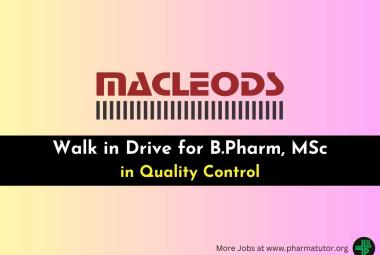{ DOWNLOAD AS PDF }
ABOUT AUTHORS:
Auti Snehal D.*1, Jadhav S. L2, Gadhave Manoj V3
1Department of Quality Assurance Techniques
2,3Department of Pharmaceutics
VJSM’S Vishal institute of pharmaceutical education and research, Ale, Pune, Maharashtra, 412411
snehal.d.auti@gmail.com
ABSTRACT:
The present research work discusses the development of a dissolution method for Fluconazole using UV spectrophotometer. Simple, accurate and cost efficient dissolution method has been developed for the estimation of Fluconazole in bulk and tablet dosage form. The optimum conditions for the dissolution of the drug were established. The dissolution media was found to be 0.1N HCl (pH 1.2). The apparatus was found to be USP II, Paddle and the speed was found to be 50 rpm for 30 minutes time interval.
[adsense:336x280:8701650588]
REFERENCE ID: PHARMATUTOR-ART-2332
|
PharmaTutor (Print-ISSN: 2394 - 6679 | e-ISSN: 2347 - 7881) Volume 3, Issue 5 How to cite this article: SD Auti, S Jadhav, MV Gadhave; Dissolution Method Devolopment of Fluconazole in Fluconazole Tablets Dossage Form; PharmaTutor; 2015; 3(5); 29-35 |
INTRODUCTION[1-4]:
Fluconazole is a triazole fungistatic agent chemically known 2-(2,4-difluorophenyl)-1,3-bis(1H-1,2,4-triazol-1-yl)propan-2-ol used in the treatment of systemic and superficial fungal infections. Fluconazole therapy can cause transient mild to moderate serum aminotransferase elevations and is a rare cause of clinically apparent acute drug induced liver injury.
Fluconazole is a fungicidal agent which inhibits lanasterol-14-α-demethylase, the enzyme responsible for ergosterol synthesis. As a consequence, fluconazole causes an increase in abnormal intracellular sterols, inhibiting the fungal cell’s ability to replicate. Fluconazole was approved for use in the United States in 1990 and currently more than 12 million prescriptions are written for it yearly. Current indications include treatment of fungal infections due to candida and cryptococcus. Fluconazole is available in multiple generic forms and under the brand name Diflucan in tablets of 50, 100, 150 and 200 mg, as well as in oral suspensions and parenteral formulations. The usual recommended dose is 100 to 400 mg daily depending upon the type and severity of the infection. Common side effects include nausea, vomiting, and headache. Literature survey revealed various methods for estimation of fluconazole in topical (creams, lotions), orals (tablets, capsule, syrups, solutions), eye drops, biological fluied (intravenous) and in other pharmaceutical formulations, such as TLC-desitometry, UV-spectrophotometry, microbiological methods, high performance liquid chromatography (HPLC) for pharmaceutical dasage form.
The aim of this work is to develop a dissolution method for determination of fluconazole from the solid dosage form and to define essential parameters required for identification. The Literature survey does not reveal any dissolution methods by using UV-spectrometer together for the determination of the drug in bulk and in pharmaceuticals. This paper reports a study on the development of a new validated dissolution method for the quantitative determination of fluconazole in bulk and solid dosage form in different simulated buffer media i.e. gastric fluid (Hydrochloric acid) (pH 1.2), phosphate buffer (pH 6.8) and acetate buffer (pH 4.5).
[adsense:468x15:2204050025]
Materials and Methods
Apparatus
Dissolution bath, UV-Visible spectrophotometer (Shimadzu-1700) connected to computer. All weights were taken on electronic balance (Mettler Toledo)
Materials
Pure sample of fluconazole was obtained from Ranbaxy, Gurgaon, India. Tablets brand name FungidTM (Batch no. SBT-910241) containing 150 mg of fluconazole, were procured from local pharmacy. Double distilled water was used as the solvent for the experiment. Hydrochloric acid, lactic acid, acetic acid, sodium chloride, calcium chloride, urea, glucose, glycerol, disodium hydrogen phosphate were purchased from Qualigens (Fisher), Mumbai, India. All the above chemicals were of analytical grade.
EXPERIMENT AND RESULT
Development Trials for Dissolution[5-7]
1.Dissolution media selection:
BCS Solubility was done as per CDER Guidance for Industry, “Waiver of In vivo Bioavailability and Bioequivalence studies for Immediate-Release Solid Oral Dosage Forms Based on a Biopharmaceutics Classification System”.
The samples were analysed by validated and stability indicating analytical method (assay method) that allows quantifying the solubilized drug, in the filtered in the presence of its possible degradation products.
Preparation of Mobile Phase A:
Prepare a solution of 0.2% Triethylamine in water. Adjust pH to 3.0 with ortho-phosphoric acid and filter through 0.45µ membrane filter.
Preparation of Mobile Phase B:
Prepare a mixture of Acetonitrile and Methanol in the ratio of 50:50.
Preparation of Mobile Phase:
Use mixture of Mobile phase A and Mobile phase B in the ratio of 40:60 sonicate to degas.
Preparation of Media
1) 0.1N HCl (pH 1.2)
Transfer accurately 8.5ml of HCl into a 1000 mL water and mix.
2) pH 4.5 Acetate buffer:
Weigh accurately 2.99gm of Sodium acetate trihydrate and 1.6 ml of glacial acetic acid into a 1000 mL of volumetric flask. Make up the volume with water and mix. Adjust pH to 4.5± 0.05 (if necessary).
3) pH 6.8 phosphate buffer:
Dissolve 6.8 gm of monobasic potassium phosphate and 0.9 gm of Sodium Hydroxide in to 1000 mL of water and mix. Adjust pH 6.8 ± 0.05 with Sodium Hydroxide solution if necessary.
Preparation of Standard solution:
Weigh accurately about 50 mg of Fluconazole working standard into a 50 mL volumetric flask. Add about 35 mL of diluent and sonicate to dissolve. Make up to the mark with diluent and mix. Dilute 5 mL of this solution to 50 mL with diluent and mix.
Preparation of Sample solution:
Transfer 250 mg of Fluconazole API in 500 mL volumetric flask. Add 250 ml of media and shake in an orbital shaker at 37°C ± 1.0°C, 150 rpm for 60 minutes
Further dilute 2.5 ml to 20 ml with media.
Filter the sample solution through 0.45µ Nylon membrane filter and inject.
Prepare sample in triplicate for each media.
HPLC Chromatographic Condition:
Column: Inertsil ODS-3V, 250 x 4.6 mm, 5µ
Column temperature: 25°C
Flow rate: 1.0 mL/min
Detetion: 254 nm
Diluent: Mobile phase
Injection volume: 20µL
Run time: 15 minutes
Retention time: About 8.5 minutes for Fluconazole
Evaluation of System suitability:
The relative standard deviation for five replicate injections of standard solution should not be more than 2.0%.
Theoretical plate count of Fluconazole peak should not be less than 2000.
Tailing factor of Fluconazole peak should not be more than 2.0
Procedure:
Separately inject the equal volumes of blank (diluent), five replicate injections of standard solution and test solution in duplicate into the chromatograph and record the chromatograms.
Measure the area count for Fluconazole peak.
Following is the solubility data obtained:
Table 1: BCS solubility of drug in various dissolution media
|
Sr.No. |
MEDIA |
pH of media before addition of API |
pH of media after addition of API |
mg/250ml |
Mean |
% Dissolved |
Solubility |
|
1 |
0.1N HCl (pH 1.2) |
1.23 |
1.20 1.22 1.21 |
193.84 193.46 196.96 |
193.76 |
96.17 |
Very Slightly soluble |
|
2 |
pH 4.5 Phosphate Buffer |
4.52 |
4.51 4.50 4.52 |
177.14 176.27 176.46 |
176.63 |
88.13 |
Very Slightly soluble |
|
3 |
pH 6.8 Phosphate buffer |
6.84 |
6.80 6.83 6.84 |
195.69 196.66 198.27 |
196.88 |
97.82 |
Very Slightly soluble |
Observation
The BCS solubility studies performed on Fluconazole API, in buffer pH ranging from pH 1.2 to pH 6.8 shows above 95% in 0.1N HCl and pH 6.8 Phosphate buffer
BCS Stability of drug in various medias
Same samples were analysed again after 24 hours along with fresh standard for solution stability.
NOW YOU CAN ALSO PUBLISH YOUR ARTICLE ONLINE.
SUBMIT YOUR ARTICLE/PROJECT AT editor-in-chief@pharmatutor.org
Subscribe to Pharmatutor Alerts by Email
FIND OUT MORE ARTICLES AT OUR DATABASE
Table 2: BCS stability of drug in various dissolution media
|
S. No |
MEDIA |
Initial solubility mg/250ml |
Solubility after 24 hours mg/250ml |
% Stability |
|
1 |
0.1N HCl (pH 1.2) |
193.76 |
192.85 |
99.5 |
|
2 |
pH 4.5 Phosphate Buffer |
176.63 |
173.67 |
98.3 |
|
3 |
pH 6.8 Phosphate buffer |
196.88 |
194.57 |
98.8 |
Observation
Fluconazole is stable in all three dissolution media mentioned above for 24 hours at room temperature.
Selection of surfactants:
The Fluconazole has sufficient solubility in all medias (0.1N HCl (pH1.2), pH 4.5 acetate buffer, pH 6.8 phosphate buffer), therefore surfactants are not needed.
Table 3: Dissolution of Fluconazole tablets 150 mg in various dissolution media
|
Media |
0.1N HCl (pH 1.2) |
pH 4.5 acetate buffer |
pH 6.8 phosphate buffer |
|
Time (mins) |
% Dissolved |
% Dissolved |
% Dissolved |
|
5 |
30 |
33 |
32 |
|
10 |
70 |
73 |
72 |
|
15 |
94 |
93 |
93 |
|
20 |
96 |
98 |
98 |
|
30 |
99 |
99 |
99 |
|
45 |
100 |
100 |
99 |
|
60 |
101 |
101 |
100 |
Observation
All three dissolution media shows similar profile at 50 rpm. Also, Fluconazole tablets being IR tablets, the tablets will dissolve in gastric fluid or 0.1N HCl (pH 1.2), invivo.
2. Selection of Apparatus:
As per USP General chapter, <1092> The dissolution procedure: Development and validation, the choice of apparatus is based on knowledge of the formulation design and the practical aspects of dosage form performance in the in vitro system. For Solid oral dosage forms Apparatus 1 and Apparatus 2 are used most frequently. Apparatus 2 (Paddle) is used for tablets and Apparatus 1 (basket) is used for capsules.
Table 4: Dissolution of Fluconazole tablets 150 mg in 0.1 N HCl (pH 1.2)
|
Apparatus Used |
Basket |
Paddle |
|
RPM |
100 rpm |
50 rpm |
|
Time (mins) |
% Dissolved |
% Dissolved |
|
5 |
71 |
75 |
|
10 |
97 |
98 |
|
15 |
97 |
99 |
|
20 |
100 |
100 |
|
30 |
103 |
102 |
|
45 |
104 |
104 |
|
60 |
109 |
108 |
As a Fluconazole tablet is tablet dosage form, Apparatus II (Paddle) was selected for dissolution method.
3. Selection of rotation:
As per USP General chapter, <1092> The dissolution procedure : Development and validation, for immediate-release capsule or tablet formulations, Apparatus 1 (baskets) at 100 rpm or Apparatus 2 (Paddles) at 50 rpm is most commonly used. Rates outside 25 to 150 rpm are usually inappropriate because of the inconsistency of hydrodynamics below 25 rpm and because of turbulence above 150 rpm. There was no coning effect at 50 rpm so 75 rpm was not tested.
Table 5: Dissolution of Fluconazole tablets 150 mg for rpm
|
RPM |
75 rpm |
50 rpm |
25 rpm |
|
Time (mins) |
% Dissolved |
% Dissolved |
% Dissolved |
|
5 |
76 |
75 |
21 |
|
10 |
88 |
98 |
45 |
|
15 |
101 |
99 |
57 |
|
20 |
105 |
100 |
72 |
|
30 |
108 |
102 |
85 |
|
45 |
107 |
104 |
95 |
|
60 |
108 |
108 |
98 |
Complete dissolution was achieved in paddle 50 rpm. Therefore 50 rpm was selected for dissolution method for Fluconazole tablets.
4. Selection of sinkers:
The Fluconazole tablets does not float in dissolution media, therefore sinkers are not needed.
5.Selection of filter:
Experiment
The Sample Preparation of Fluconazole tablets will be filtered in triplicate through one or more, different types of filters and then analyzed.
Sample Preparation
Performed the dissolution for Fluconazole tablets 50 mg and 200 mg. Sample from one dissolution vessel will be filtered in triplicate through one or more different types of filters such as Nylon 0.45m, Teflon 0.45µfilter discarding first two mL of the filtrate. Additionally the solution from the same dissolution vessel was also centrifuged in triplicate. The filtrate and the centrifugate were analysed.
Table 6: Filter equivalency for Fluconazole tablets 150 mg
|
|
% Dissolved |
||
|
No. |
Centrifuged |
Nylon 0.45µ |
Teflon 0.45µ |
|
1 |
100 |
100 |
99 |
|
2 |
100 |
100 |
99 |
|
3 |
99 |
100 |
99 |
|
Mean |
100 |
100 |
99 |
|
% Correlation with centrifuged |
-- |
100 |
99 |
Acceptance Criteria: Percent correlation of filtered sample response with respect to centrifuged sample response should be 98-102%.
6. Method Development for analysis of samples
The Fluconazole shows UV lambda max at 254nm. So specificity was carried out on UV.
Standards and samples were diluted so as to get absorbance less than 1.
Specificity:
Prepared Placebo solution of Fluconazole Tablets. Also prepared a representative blank (Dissolution Medium), Standard Preparations and Sample Preparations of Fluconazole Tablets. Measured the UV absorbances of all the above solutions.
NOW YOU CAN ALSO PUBLISH YOUR ARTICLE ONLINE.
SUBMIT YOUR ARTICLE/PROJECT AT editor-in-chief@pharmatutor.org
Subscribe to Pharmatutor Alerts by Email
FIND OUT MORE ARTICLES AT OUR DATABASE


Table : Table for specificity
|
Sr. No |
Sample Name |
% Interference |
|---|---|---|
|
1 |
Placebo of Fluconazole Tablets |
0.0 |
Table 7: Table for Specificity
|
Sr. No. |
Sample Name |
Wavelength max. |
|
1 |
Standard of Fluconazole Tablets |
255.50 nm |
|
2 |
Sampleof Fluconazole Tablets 150 mg |
255.47 nm |
Acceptance criteria: The interference from placebo should not be more than 2%.
7.Specifications:
As per USFDA recommended, the time points of 10, 20, 30 and 45 minutes need to be sampled.
The Fluconazole tablet is immediate release tablets and shows % dissolved of more than 85% in 20 minutes.
Therefore, specifications were finalized as “Not less than 80 % (Q) of labeled amount of drug is dissolved in 20 minutes”.
Final Dissolution method
Preparation of Dissolution media: (0.1N HCl) pH 1.2
Dilute 85 mL of concentrated HCl to 10 L with water.
Dissolution Parameters:
Apparatus: USP II, Paddle
Dissolution Medium: 900 mL, 0.1N HCl(pH 1.2)
Temperature: 37°C + 0.5°C
Speed: 50 rpm
Interval: 30 minutes
Preparation of Standard solution:
Weigh accurately about 50.0 mg of Fluconazole working standard into a 100 mL volumetric flask. Add about 50 mL of methanol and sonicate to dissolve. Make up to the mark with methanol and mix. Dilute 4 mL of this solution to 100 mL with dissolution medium and mix.
Preparation of Sample solution:
Fluconazole tablets 150 mg
Place one tablet in each dissolution vessel and carry out dissolution. Withdraw 10 mL of solution after each time interval. Filter through stainless steel filter. Dilute 4 mL of the filtrate to 10 mL with dissolution medium and mix.
Evaluation of System Suitability:
Record the absorbance of the standard solutionfive times.The %RSD for five replicate measurements of standard solution is not more than 2.0.
Procedure:
Measure the absorbance of standard solution and sample solution at 254 nm using dissolution medium as blank.
Calculation:
Calculate the percentage of Fluconazole released from the tablets by the following formula:
Fluconazole tablets 150 mg
% Dissolved=
AT Std. wt.(mg) 4 mL 900 mL 10 mL P 100
----- x ------------ x -------x --------- x ------- x ---- x ----
AS 100 mL 100 mL 1 tab 4 mL 100 LC
CONCLUSION
From above study it is concluded that in case of selection of dissolution media 0.1N HCl (pH 1.2) media is most suitable for dissolution of Fluconazole tablets. The Mean Filtration Recovery is within limits for Nylon 0.45 µ and Teflon 0.45µ filter. Therefore, Teflon 0.45µ and Nylon 0.45µ filter are suitable for filtration of samples in the HPLC method for the dissolution samples of Fluconazole tablets. The interference from placebo is less than 2%. Also, the scans of Standard and samples show same lambda maxima. Therefore, the UV method for the dissolution of Fluconazole in Fluconazole tablets is found to be specific and will be used for analysis of dissolution samples of Fluconazole tablets.
REFERENCES:
1. drugbank.ca/drugs/DB00196
2. Klavs F, Analytical profiles of Drug and Excipients (Academic Press, An Imprint of Elsevier, New Jersey), 27(1987) 67-112.
3. Martidale, The Extra Pharmacopoeia, edited by JEF Renolds (Royal Pharmaceutical Soc.,London), 1990, 404-406.
4. Hillis J, Morelli I, Neville D, Fox J and Leary A C, Chromatogr, 67 (11/12) 2008, 995-998.
5. CDER Guidance for Industry, “Waiver of In vivo Bioavailability and Bioequivalence studies for Immediate-Release Solid Oral Dosage Forms Based on a Biopharmaceutics Classification System”.
6. USP General chapter <1092> The dissolution procedure : Development and validation.
7. USP General Chapter <711> Dissolution.
NOW YOU CAN ALSO PUBLISH YOUR ARTICLE ONLINE.
SUBMIT YOUR ARTICLE/PROJECT AT editor-in-chief@pharmatutor.org
Subscribe to Pharmatutor Alerts by Email
FIND OUT MORE ARTICLES AT OUR DATABASE









